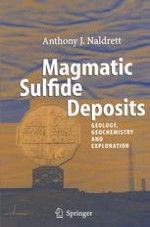2004 | OriginalPaper | Buchkapitel
Deposits of the Pechenga area, Russia
verfasst von : Professor Anthony J. Naldrett
Erschienen in: Magmatic Sulfide Deposits
Verlag: Springer Berlin Heidelberg
Enthalten in: Professional Book Archive
Aktivieren Sie unsere intelligente Suche, um passende Fachinhalte oder Patente zu finden.
Wählen Sie Textabschnitte aus um mit Künstlicher Intelligenz passenden Patente zu finden. powered by
Markieren Sie Textabschnitte, um KI-gestützt weitere passende Inhalte zu finden. powered by
The deposits of the Pechenga area are associated with a major Early Proterozoic rift system that is referred to in Russia as the Pechenga-Varzuga sedimentary-volcanic belt (e.g. Smolkin et al. 1995a), and referenced as the Polmak — Opukasjarvi — Pasvik — Pechenga — Imandra/Varzuga — Ust’Ponoy greenstone belt in some of the Western literature (e.g. Melezhik et al. 1995). This belt traverses the northeastern part of the Fennoscandian shield for a distance of about 700 km (Fig. 5.1). It includes a series of depressions filled by Early Proterozoic sedimentary and volcanic rocks (the Polmak, Pasvik, Pechenga, Imandra-Varzuga and Ust’Ponoy Structures) that occur within a reactivated Archean basement, that is cut by dikes and granitoid intrusions in intervening areas. The belt developed at about 2.3 Ga, after the emplacement and partial erosion of a series of peridotitegabbronoritic layered intrusions, (Mt. Generalskaya, Monchegorsk, Pana and Fedorova Tundra which are the equivalents of the 2.5–2.4Ga intrusions of Northern Finland — see Chapter 9). Rifting started in the eastern and central parts of the Imandra-Varzuga structure and propagated to the west. The greatest amount of spreading along the rift occurred in the Pechenga area (Smolkin 1992, 1993, 1997). Northwest-oriented compression took place from 1.75–1.70 Ga and the belt, especially the southern part, suffered intense deformation and greenschist to amphibolite metamorphism (Smolkin at al. 1995a).
